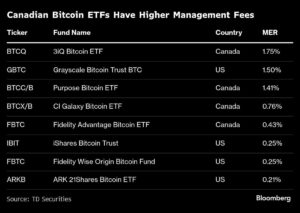The Great Bitcoin ETF Shift: What Investors Should Know
In 2023, Bitcoin has experienced a meteoric rise, up over 150% from the previous year. Yet, as the cryptocurrency market continues to evolve, the once-pioneering Canadian Bitcoin ETFs may find themselves struggling to keep pace with their U.S. counterparts. Here’s an in-depth exploration of the current landscape of Bitcoin ETFs and the implications for investors.
A Record-Breaking Year for Bitcoin
The surge in Bitcoin’s price has driven significant interest across the investing spectrum. However, there’s a stark contrast between the fortunes of Canadian Bitcoin ETFs and those of their newly launched U.S. counterparts. While Canadian ETFs saw C$578 million ($405 million) in net outflows this year, U.S. Bitcoin ETFs raked in a staggering $36 billion in inflows.
Initially launched in February 2021, Canadian Bitcoin ETFs—like the Purpose Bitcoin ETF (BTCC)—led the charge for digital asset exposure. But with the approval of U.S. Bitcoin ETFs, many investors, particularly from the U.S., have pivoted their interests, shifting funds away from Canadian options.
The Competitive Edge of U.S.-Based ETFs
The decision to switch from Canadian to U.S. Bitcoin ETFs isn’t arbitrary. Several factors contribute to this trend, including the relative advantages offered by U.S. counterparts:
-
Lower Management Fees:
Investors have become increasingly cost-conscious, recognizing that U.S. Bitcoin ETFs generally feature lower management expense ratios (MERs). For instance, the largest U.S. Bitcoin ETF, the iShares Bitcoin Trust, boasts a competitive 0.25% sponsorship fee, whereas many Canadian ETFs have MERs exceeding 1%. The Fidelity Advantage Bitcoin ETF has emerged as one of the lowest-cost options at 0.43%. -
Market Liquidity:
Liquidity is critical for investors, especially larger institutional players who leverage U.S. markets for their investments. Vlad Tasevski from Purpose Investments explains that the dominance of U.S. capital markets, which offer higher liquidity, has attracted many global investors. - Currency Management Options:
Canadian Bitcoin ETFs offer options for managing currency risk through Canadian dollar-denominated and hedged investments. While this feature appeals to local investors, it may not be enough to deter a shift towards U.S. markets for others looking for efficiency and performance.
Canadian Market Dynamics
While U.S. Bitcoin ETFs grew exponentially, Canadian ETFs experienced a different dynamic. Some Canadian investors have held onto their investments, partially due to a weaker Canadian dollar. This localized preference can be beneficial, as it allows Canadians to mitigate currency risk.
Moreover, despite the outflows, it’s worth noting that Purpose’s Bitcoin ETF still enjoys a significant base of Canadian investors, making up over 80% of its customer demographic. The local market is indeed more mature, where individual investor decisions may be more tactical in nature, influencing longer-term strategies.
The Outlook for Canadian Bitcoin ETFs
Despite the current outflows, the Canadian crypto ETF landscape isn’t without promise. The anticipation surrounding changes in the U.S. regulatory framework could signal new opportunities for Canadian funds. As more varied cryptocurrency ETFs emerge, we might see a resurgence in interest from investors looking to diversify their portfolios.
Andres Rincon of TD Securities conveys optimism, suggesting that incoming changes from the U.S. Securities and Exchange Commission may lead to a renewed wave of filings, possibly re-energizing Canadian offerings.
Conclusion: The Changing Tides of Bitcoin Investing
The narrative surrounding Bitcoin ETFs is continually shifting, influenced by market trends, regulatory changes, and investor preferences. While Canadian ETFs paved the way, U.S. ETFs now hold significant advantages, capturing the lion’s share of new money.
For Canadian investors, the key will be to remain vigilant about costs and market trends, understanding that while local offerings provide unique benefits, the global landscape is becoming increasingly competitive. As a savvy investor, staying informed and adaptable will be crucial in capitalizing on the ever-evolving crypto market.
For more insights, strategies, and investment intelligence, stay tuned to Extreme Investor Network, where we aim to empower investors with knowledge in the dynamic world of finance.

